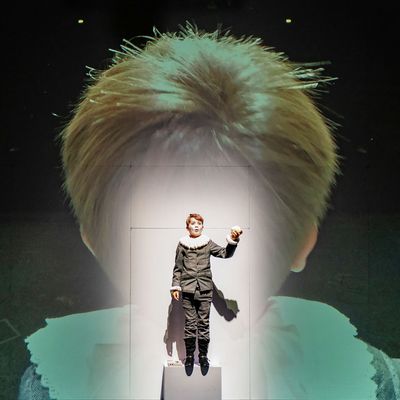
The best moment of Hamnet is the first one. (Sometimes you find that in work thatÔÇÖs pushing the possibilities of new technologies in theater: ThereÔÇÖs one powerful image, and then a fading series of ideas tries to pick it clean.) The audience spends the minutes before the show looking at a giant picture of itself. A live video feed of the auditorium fills the stageÔÇÖs large back wall; we watch in real time as we filter in and shuffle about and shrug out of our coats. We get so used to thinking of the screen as a mirror that when the lights dim and a young boy comes down the aisle, we assume heÔÇÖs coming through the seats beside us. But he isnÔÇÖt there. The video image has stopped showing us the truth and started to show us a fiction, but our minds hang onto the sense of ÔÇ£realityÔÇØ ÔÇö and the video boy manifests in the projection like a ghost.
Lovely! WeÔÇÖve been tricked by an empty stage, and so when thereÔÇÖs a bright flash and the physical child himself shows up (Aran Murphy, in a sweatshirt and sneakers), we manage to hold him a little gingerly in our minds ÔÇö he could go at any moment, despite his obvious nowness and realness. This is Hamnet, a bewildered 11-year-old kid of our own era. He talks about his weird name, which often gets mistaken for another more famous one; he talks to us in person and to Google on his smartphone; he mourns his missing father, whose massive Collected Works become his anchor on the white stage. He finds a victim in the audience and makes him read the GhostÔÇÖs part from Hamlet (ÔÇ£You should know this play! YouÔÇÖre 50!ÔÇØ he says, rather brightly) ÔÇö though he struggles to understand the words. Because Hamnet is also somehow ShakespeareÔÇÖs son, the actual boy who died young just a few years before Hamlet was written.
The Anglo-Irish group Dead Centre ÔÇö a collective based between Dublin and London ÔÇö is preoccupied by hauntings. An earlier production of theirs, Lippy, imagined what happened inside a real life Irish house-of-horrors, where a woman and her nieces deliberately starved themselves to death. The co-directors, Bush Moukarzel and Ben Kidd, created an interior that was one part Beckett play, one part art installation, with mysterious figures emerging out of hazmat suits and garbage bags. The group has also brought to New York MoukarzelÔÇÖs solo show Souvenir, in which he affably, but brokenheartedly, told us a Proustian history of objects left behind. So Hamnet would seem to be right in their sweet spot: It deals with loss and its metaphysical echoes.
But Hamnet falls apart almost immediately. Limbo is by definition an aimless place to be, and it takes an expertÔÇÖs touch to make nothingness and waiting into something compelling. In only 60 minutes, so much shouldnÔÇÖt sound like filler. The playÔÇÖs arc rises and falls with the childÔÇÖs dawning awareness that he isnÔÇÖt alive, and writer-directors Moukarzel and Kidd donÔÇÖt work out how to prolong the realization into an evening-length event. They keep the boy only as unevenly innocent as the plot needs him to be (he doesnÔÇÖt know the meaning of ÔÇ£wanker,ÔÇØ but heÔÇÖs happy to quote Trump on grabbing), and so this unconvincing adolescent wanders, banging the ÔÇ£I maybe inspired HamletÔÇØ drum without striking any insight into bereavement or the Danish tragedy. Also ÔÇö beware a show trying to make a fuzzy-minded connection to pop science. Here itÔÇÖs ÔÇ£quantum tunnelingÔÇØ: Hamnet bounces his ball against the back wall, assuring us that if he does it an infinite number of times, it will eventually pass through. Ah! A metaphor for the veil between life and death! Which is, crucially, already a metaphor.
Then the team brings on Shakespeare (Moukarzel). He exists mainly as a special effect, an augmented-reality figure in the projected space that we watch on screen. The adult reflection and the real boy interact in the video space, and the tone changes from precocious to glum. ÔÇ£I wrote to you. Did you see? IÔÇÖm still writing to you in a way. Just wanted to say hello,ÔÇØ Shakespeare says, his voice low. ItÔÇÖs a big miscalculation. Moukarzel has many strengths as an actor ÔÇö vivacity, warmth, unpretentiousness ÔÇö but he canÔÇÖt use any of them at this slow, self-serious pace. God knows his gravity doesnÔÇÖt survive the baggy pantaloons and fake beard.
Even in the otherworld theyÔÇÖre inhabiting, father and sonÔÇÖs behavior makes no sense: Shakespeare tells his desperate, yearning boy that heÔÇÖs been watching from the back of the theater, staying away ÔÇö for some reason? Yet he also lays claim to terrible sorrow. The Kidd-Moukarzel team isnÔÇÖt sure if theyÔÇÖre more interested in parental neglect (the real Shakespeare probably rarely saw Hamnet, and he might not have attended his funeral) or parental loss. The second one seems weightier, and so itÔÇÖs where the play settles: Moukarzel recites a few lines from King John ÔÇö the bitter speech, ÔÇ£Grief fills the room up of my absent child.ÔÇØ But the actual sound of Shakespeare, of poetry, deforms everything around it. ItÔÇÖs so heavy, so patently beautiful, the rest of the show collapses in its presence. Fake-beardy Shakespeare stutters between his carnal and digital states, and Hamnet returns with his ball, but our thoughts are already far off, chasing the sound of something richer and stranger. Skip the show and spend an hour reading King John. You can throw your mind against those words as many times as you like, but they will never let you through.
Hamnet is at the Brooklyn Academy of Music through November 3.


